Welcome to our comprehensive guide on how and when to plant a garden for the best results. Whether you’re a seasoned gardener or a beginner looking to try your hand at growing your own vegetables, this guide will provide you with the knowledge and tips you need to create a successful garden.
Gardening can be a rewarding and fulfilling hobby, especially when you get to enjoy the delicious flavors and textures of freshly grown vegetables. By planting and tending to your own garden, you’ll have access to the best produce that you’ve ever tasted. Plus, the satisfaction of growing your own food is unparalleled.
In this guide, we’ll cover everything you need to know about planting a garden. We’ll start with the basics of vegetable gardening, including how to choose the right site, determine the appropriate size, and select the best vegetables for your garden. We’ll also explore the different planting seasons for vegetables based on your climate and region.
Key Takeaways:
– This comprehensive guide will provide you with tips and techniques on how and when to plant a garden for the best results.
– Vegetable gardening can be a rewarding hobby that allows you to enjoy fresh, homegrown produce.
– Choosing the right location, plot size, and vegetables is crucial for the success of your garden.
– Sowing seeds and understanding the planting seasons will help you achieve a bountiful harvest.
– Selecting the right location and plot size, as well as starting small, will make gardening more manageable for beginners.
– Easy-to-grow vegetables and a list of the top 10 easiest vegetables to grow are recommended for beginners.
– Knowing where and when to plant different vegetables based on their growing conditions is essential for optimal growth and development.
– Gardening is a rewarding experience that allows you to enjoy the benefits of fresh, homegrown vegetables.
Basics of vegetable gardening and help you get started on the right foot
Gardening can be a rewarding hobby that allows you to grow your own fresh and delicious produce. Whether you have a small backyard or a spacious garden, vegetable gardening is a great way to connect with nature and enjoy the fruits of your labor. If you’re just starting out, here are some vegetable gardening tips to help you get started:
- Choose the right location: Select a sunny spot for your garden, as most vegetables need at least 6 to 8 hours of direct sunlight per day. Ensure that the location has good drainage and is protected from strong winds.
- Plan your garden: Before you start planting, take some time to plan your garden. Consider the size of your space and the vegetables you want to grow. Start small and choose vegetables that are easy to grow for beginners, such as lettuce, green beans, and radishes.
- Prepare the soil: Conditioning the soil is important for the health and productivity of your plants. Mix compost and natural fertilizers into the soil to provide essential nutrients. Consider getting your soil tested to determine its acidity and make any necessary adjustments.
- Follow planting instructions: Each vegetable has different planting requirements, so be sure to read the instructions on the seed packets or plant labels. Pay attention to the recommended planting depth and spacing to ensure that your plants have enough room to grow.
- Water regularly: Proper watering is crucial for the success of your garden. Water your plants regularly, keeping the soil evenly moist. Avoid over-watering, as it can lead to root rot and other problems.
- Mulch to prevent weeds: Mulching is an effective way to control weeds and conserve moisture in the soil. Apply a layer of organic mulch around your plants to suppress weed growth and maintain soil moisture.
- Monitor for pests and diseases: Keep an eye out for common pests and diseases that can affect your vegetables. Take preventive measures, such as using organic pest control methods and practicing crop rotation, to minimize the risk of infestations.
- Harvest at the right time: Harvest your vegetables when they are ripe and ready to be eaten. Each vegetable has its own harvesting time, so refer to the planting instructions or do some research to ensure that you pick them at the optimal stage.
Remember, gardening is a learning process, and it’s okay to make mistakes along the way. Don’t get discouraged if things don’t go perfectly in your first season. With time and experience, you’ll become a more confident and successful gardener. So roll up your sleeves, get your hands dirty, and enjoy the journey of growing your own food!
“Gardening requires lots of water – most of it in the form of perspiration.” – Lou Erickson
Understanding When to Plant Vegetables
Knowing when to plant your vegetables is crucial for a successful garden. Let’s dive into the different planting seasons and find out the best time to plant each vegetable.
Planting season varies depending on the climate and region. Different vegetables have different temperature requirements for germination and growth. It’s important to consider the average last frost date in your area and the specific needs of each vegetable.
| Vegetable | Planting Season |
|---|---|
| Lettuce | Early spring, before the last frost, and in the fall for a second crop |
| Tomatoes | After the last frost, when soil temperatures reach 60°F or above |
| Cucumbers | After the last frost, when soil temperatures reach 70°F or above |
| Carrots | Early spring, as soon as the soil can be worked |
| Peppers | After the last frost, when soil temperatures reach 65°F or above |
| Beans | After the last frost, when soil temperatures reach 60°F or above |
“Planting season varies depending on the climate and region. Different vegetables have different temperature requirements for germination and growth.”
It’s important to note that these are general guidelines, and you should always check the specific planting recommendations for each vegetable you plan to grow. Seed packets usually provide planting instructions and recommended planting times for different regions.
By understanding the planting seasons and following the recommendations for each vegetable, you can ensure that your garden gets off to a healthy start and maximizes its potential for a bountiful harvest.
Key Takeaways:
- Planting season varies depending on the climate and region.
- Each vegetable has different temperature requirements for germination and growth.
- Check the specific planting recommendations for each vegetable you plan to grow.
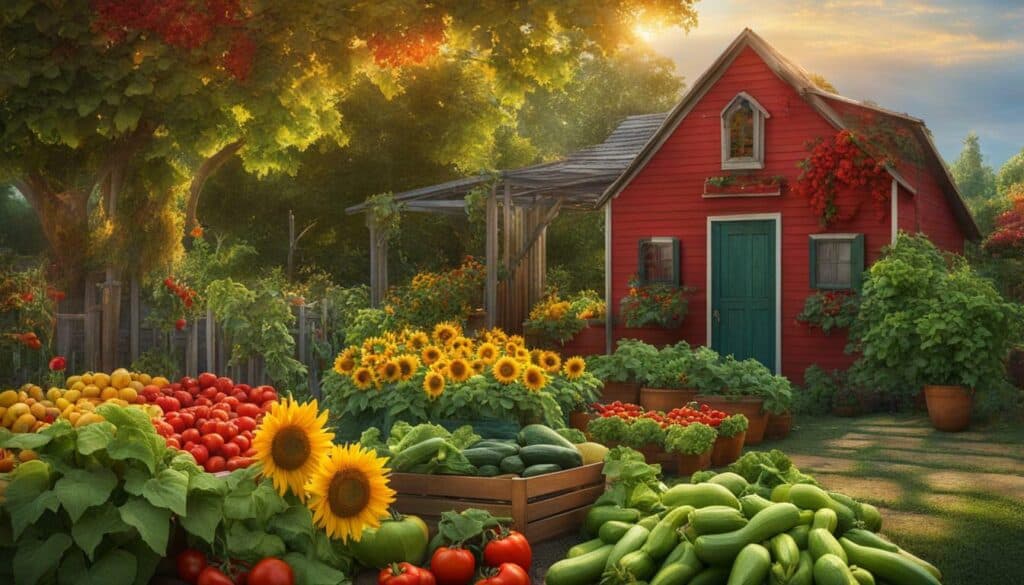
With this knowledge, you can confidently plan your planting schedule and enjoy a thriving vegetable garden throughout the growing season.
Sowing Seeds in the Vegetable Garden
Sowing seeds is an essential step in starting your vegetable garden. Let’s take a closer look at how to sow seeds and set yourself up for a bountiful harvest.
When it comes to sowing seeds, there are a few key factors to consider for successful germination and growth. Here are some seed planting tips to help you get started:
- Prepare the soil: Before sowing seeds, it’s important to prepare the soil properly. Make sure the soil is well-draining and rich in nutrients. You can improve the soil by adding compost or organic matter.
- Select the right seeds: Choose high-quality seeds that are suited to your growing conditions and preferences. Consider factors such as plant variety, disease resistance, and maturity time.
- Follow seed packet instructions: Each seed variety has specific planting instructions that you should follow for optimal results. The seed packet will provide information on spacing, planting depth, and recommended planting times.
- Prepare the seedbed: Create a seedbed by loosening the soil with a garden fork or rake. Remove any weeds or debris that may interfere with seed growth.
- Sow the seeds: Use your fingers or a small garden trowel to create furrows in the seedbed. Place the seeds according to the recommended spacing and depth indicated on the seed packet. Gently cover the seeds with soil or vermiculite.
- Water the seeds: After sowing the seeds, give them a thorough watering. Be careful not to wash away the seeds or compact the soil. Provide regular, consistent moisture to keep the soil moist but not waterlogged.
- Provide proper lighting: Place the seed trays or containers in a location that receives adequate sunlight or use grow lights if necessary. Most vegetable seeds require 6 to 8 hours of direct sunlight per day for optimal growth.
- Monitor and care for seedlings: As the seeds germinate and seedlings emerge, keep an eye on their growth and make sure they have enough space to develop. Thin out crowded seedlings to prevent competition for resources.
- Protect seedlings from pests: Take measures to protect young seedlings from pests such as slugs, snails, and birds. Consider using organic pest control methods or physical barriers to prevent damage.
- Harden off seedlings: Before transplanting seedlings into the garden, gradually expose them to outdoor conditions to harden them off. This helps them adjust to temperature fluctuations and reduces the risk of transplant shock.
Quote: “Sowing seeds is not just about planting; it’s the beginning of a journey towards a flourishing garden.” – Unknown
Sowing seeds in your vegetable garden is a rewarding experience that allows you to nurture and watch your plants grow from the very beginning. By following these seed planting tips, you can set yourself up for success and enjoy a bountiful harvest of homegrown vegetables.

Remember, each seed is filled with potential, waiting to burst forth and contribute to your garden’s success. Happy sowing!
What to Plant in a Victory Garden
Are you interested in planting a victory garden? Let’s explore the history and purpose of victory gardens, and discover some great vegetables to include in yours.
A victory garden is a term that originated during World War I and II, referring to a home garden that was grown by the general public to contribute to the war effort. The purpose of these gardens was to supplement the food supply during times of rationing and promote self-sufficiency. Victory gardens became a symbol of patriotism and resilience, as people took pride in growing their own food.
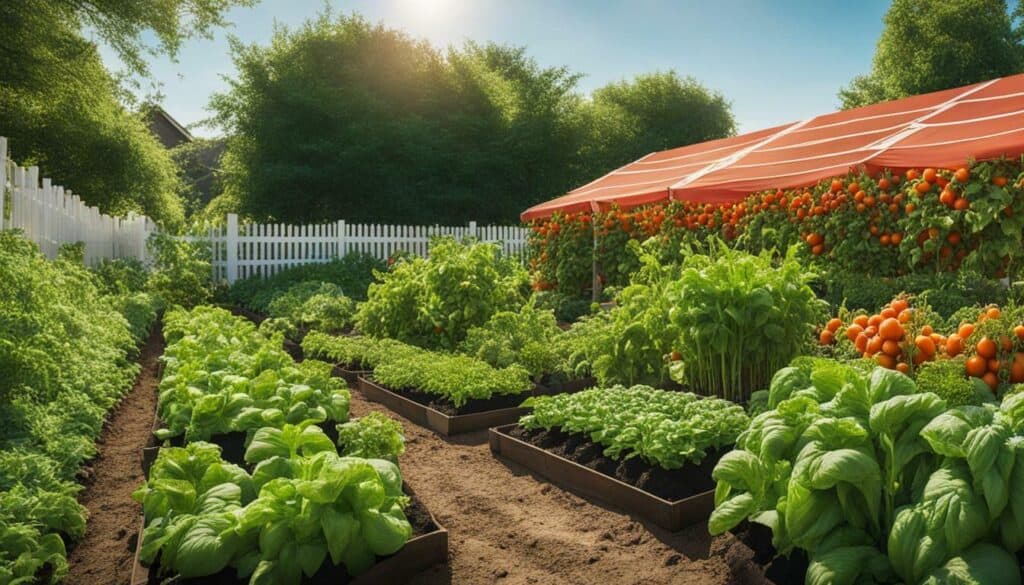
A victory garden can be a rewarding and fulfilling project, allowing you to enjoy the freshness and flavors of homegrown vegetables while reducing your environmental footprint. Here are some great vegetables to consider planting in your victory garden:
| Vegetable | Why It’s Great |
|---|---|
| Lettuce | Lettuce is easy to grow and perfect for salads. It matures quickly, allowing for multiple harvests throughout the season. |
| Tomatoes | Tomatoes are a staple in many dishes, and homegrown tomatoes have an unbeatable flavor. There are many varieties to choose from, including cherry tomatoes and heirlooms. |
| Beans | Beans are versatile and can be enjoyed fresh or preserved. They are also a great source of protein, making them a valuable addition to your victory garden. |
| Carrots | Carrots are nutritious and delicious, and they can be harvested when young for a sweeter flavor. They are also a great choice for container gardening. |
| Cucumbers | Cucumbers are refreshing and perfect for salads, pickling, or snacking. They can be trellised to save space in your garden. |
Gardening is a way to connect with nature and foster self-sufficiency. By planting a victory garden, you can contribute to food security while enjoying the benefits of homegrown produce.”
So, why not start your own victory garden? Whether you have a small space or a large backyard, growing your own vegetables can be a rewarding and fulfilling experience. Remember to choose vegetables that you and your family enjoy eating and consider the specific growing conditions in your area.
Additional Tips:
- Include herbs such as basil, parsley, and mint for added flavor and fragrance in your victory garden.
- Consider companion planting to maximize space and deter pests. For example, plant marigolds near your vegetables to repel harmful insects.
- Keep track of planting dates and follow the recommended spacing guidelines for each vegetable to ensure optimal growth.
“A victory garden is not only a source of fresh, nutritious food but also a reflection of resilience and self-sufficiency. Start your own garden today and reap the rewards of homegrown vegetables!”
Choosing the Right Location for Your Garden
Choosing the right location for your garden is crucial for the success of your plants. Let’s discuss the key factors to consider when picking the perfect spot.
Sunny spot
Most vegetables need 6 to 8 hours of direct sunlight per day. There are a few veggies (mostly leafy ones) that will tolerate some shade.
Drains well and doesn’t stay wet
If you have poorly drained soil where water pools, plant veggies in a raised bed or raised row for improved drainage. Wet soil means wet roots, which can turn into rotted roots. If you have rocky soil, till and remove the rocks, as they will interfere with root growth and make for weaker plants.
Stable and not windy
Avoid places that receive strong winds that could knock over your young plants or keep pollinators from doing their job. Nor do you want to plant in a location that receives too much foot traffic or floods easily. Plant in a location that would make Goldilocks smile—somewhere that’s “just right.”
Nutrient-rich soil
Your soil feeds your plants. If you have thin, nutrient-poor soil, you’ll have poor, unhealthy plants. Mix in plenty of organic matter to help your plants grow. See how to prepare your soil for vegetable plants.
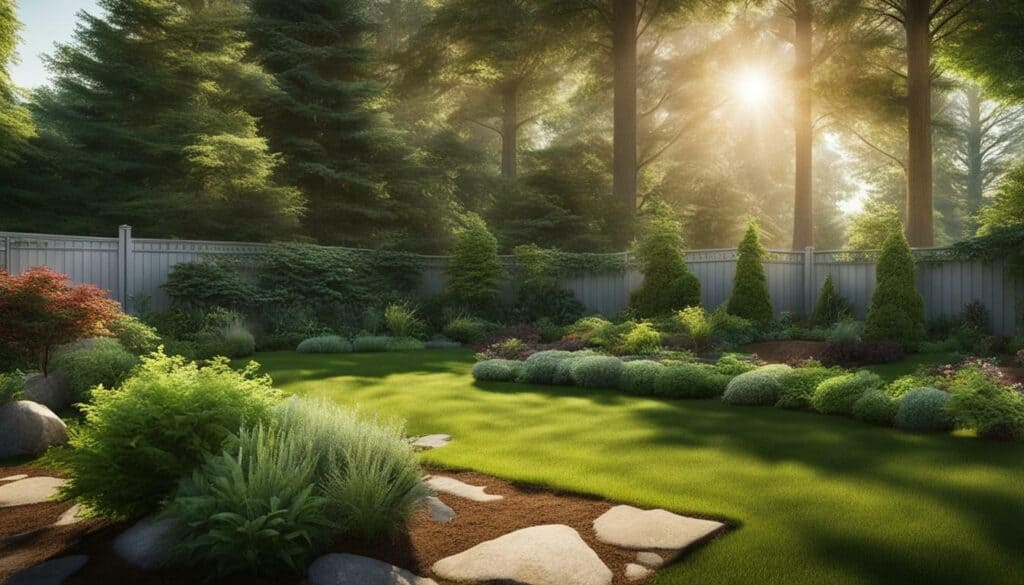
Choosing the Right Location for Your Garden
- Choose a spot with plenty of sunlight, ideally 6 to 8 hours per day.
- Ensure the soil drains well and does not stay overly wet.
- Avoid locations with strong winds or heavy foot traffic.
- Select a spot with nutrient-rich soil or amend the soil with organic matter.
Choosing a Plot Size: Start Small!
Starting with a small garden is the best way to begin your gardening journey. Not only will it be more manageable for beginners, but it will also help you avoid feeling overwhelmed with maintenance. Remember, it’s better to be proud of a small garden than be frustrated by a big one!
If you’re planting in the ground, a 10′ x 10′ garden (100 square feet) is a great size for beginners. This will give you enough space to grow 3 to 5 of your favorite vegetables, buying 3 to 5 plants of each variety.
For those opting for a raised bed, a 4′ x 4′ or 4′ x 8′ size is ideal. Raised beds have many benefits, including improved soil drainage and easier access for maintenance. Check out our Raised Garden Bed Guide for more information on building and filling a raised bed.
If you’re feeling a bit more ambitious and want to go bigger, a 12′ x 24′ garden in the ground is suitable for a first-timer. This size can provide enough veggies to feed a family of four. Consider planting 3 hills of yellow squash, 1 mound of zucchini, 10 assorted peppers, 6 tomato plants, 12 okra plants, a 12-foot row of bush beans, 2 cucumbers on a cage, 2 eggplants, 6 basil, 1 rosemary, and a few low-growing herbs like oregano, thyme, and marjoram.
Whichever size you choose, remember to leave paths every four feet or so to easily access your plants for weeding and harvesting. It’s important to avoid stepping on the soil, so plan the layout accordingly.
Benefits of Starting Small
Starting with a small garden has several advantages for beginners. Here are a few reasons why it’s a smart choice:
- Manageable maintenance: A smaller garden requires less time and effort to maintain, allowing you to learn and develop your gardening skills at a comfortable pace.
- Cost-effective: A smaller garden means fewer expenses on plants, seeds, soil, and other gardening supplies, making it more budget-friendly.
- Less overwhelming: Starting small reduces the risk of feeling overwhelmed by the tasks involved in gardening. It allows you to focus on a few crops and learn how to care for them effectively.
Remember, gardening should be a joyful and rewarding experience. Starting small will set you up for success and help you cultivate a thriving garden.
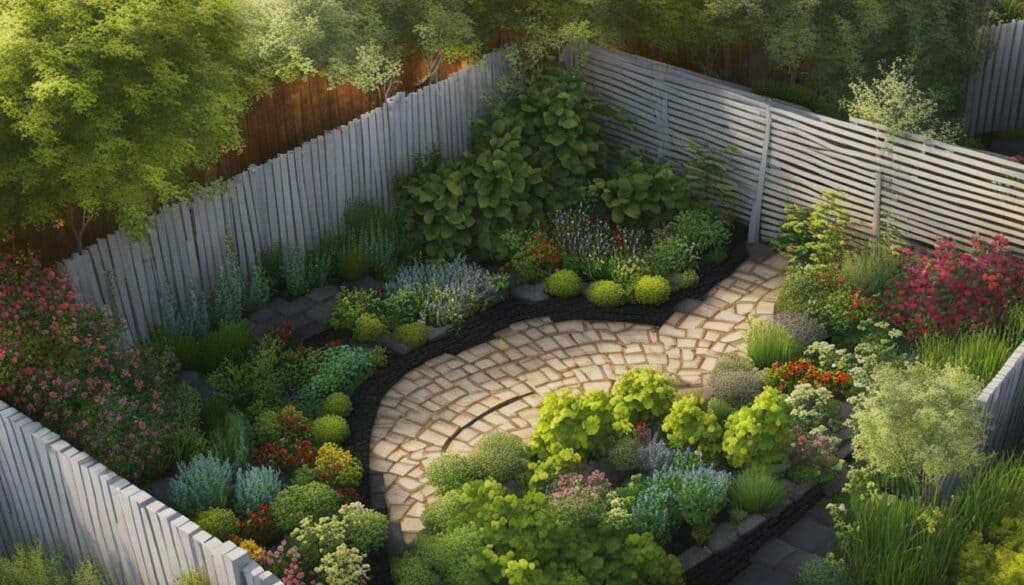
So, whether you choose a small plot in your backyard or a raised bed on your patio, starting small is the key to a successful gardening journey. Embrace the process, learn from each season, and enjoy the homegrown fruits and vegetables that will soon grace your table.
Choosing the Right Vegetables for a Successful Harvest
Choosing the right vegetables for your garden is key to a successful harvest. Let’s discover the best vegetables for beginners and how to ensure a fruitful yield.
Top 10 Easiest Vegetables to Grow
As a beginner, it’s important to start with vegetables that are easy to grow and maintain. Here are the top 10 easiest vegetables for beginners:
- Lettuce
- Green beans
- Radishes
- Tomatoes (by transplant, i.e. small nursery plant)
- Zucchini
- Peppers (by transplant, i.e. small nursery plant)
- Beets
- Carrots
- Chard, Spinach, or Kale
- Peas
These vegetables are not only easy to grow, but they also provide delicious and nutritious produce for your table. They can be planted directly into the soil, except for tomatoes and peppers, which are best started as small nursery plants. Remember to mix in some marigolds among your vegetables to deter pests and add some color to your garden.

Five Tips for Choosing Vegetables
When selecting vegetables for your garden, keep these tips in mind:
- Choose vegetables that you and your family enjoy eating. Plant what you love to eat!
- Be realistic about how much you and your family can consume. Avoid overplanting, as it can be overwhelming to care for too many plants.
- Consider the availability of certain vegetables at your local grocery store. If a vegetable is readily available, you may want to prioritize other vegetables that are more expensive or taste better when homegrown.
- Be prepared to provide care for your plants throughout the growing season. Plan for any vacations or times when you may not be able to tend to your garden.
- Use high-quality seeds or nursery plants to ensure successful germination and growth. Investing a little extra in quality seeds will yield higher yields at harvest time.
By following these tips and selecting the right vegetables for your garden, you’ll set yourself up for a successful and rewarding gardening experience. Happy planting!
Where and When to Plant
Knowing where and when to plant your vegetables is essential for their growth and development. Let’s explore the best planting locations and schedules for different vegetables.
When it comes to planting vegetables, selecting the right location is crucial. Here are a few tips for choosing the optimal planting location:
- Sunny spot: Most vegetables require 6 to 8 hours of direct sunlight per day. While some leafy vegetables can tolerate partial shade, it is best to choose a spot that receives ample sunlight.
- Well-drained soil: Ensure that your soil drains well and doesn’t stay excessively wet. If you have poorly drained soil, consider planting your vegetables in raised beds or raised rows to improve drainage. Remove rocks from the soil, as they can hinder root growth.
- Stable and sheltered: Avoid planting in areas that are prone to strong winds, as they can damage young plants and interfere with pollination. Also, refrain from choosing locations with heavy foot traffic or that are prone to flooding.
- Nutrient-rich soil: Your soil plays a vital role in your plants’ health. Ensure that you have nutrient-rich soil by incorporating organic matter, such as compost, into the soil. This will help provide essential nutrients for your plants to grow.
By considering these factors, you can select a favorable planting location that will promote optimal growth and yield for your vegetables.
Planting Schedule
Now that you have chosen the perfect location for your garden, it’s essential to follow a planting schedule to ensure that your vegetables thrive. Keep in mind that not all vegetables are planted at the same time. Here are some general guidelines for arranging your vegetables:
- Cool-season vegetables: Vegetables such as lettuce, broccoli, and peas prefer cooler temperatures. Plant them in the early spring or fall when the weather is cooler.
- Warm-season vegetables: Vegetables like tomatoes, peppers, and cucumbers thrive in warmer weather. Wait until the soil has warmed up in late spring or summer to plant them.
- Spacing considerations: Pay attention to the spacing requirements for each vegetable. Ensure that you leave enough room between plants to allow for proper growth and airflow.
- Successive planting: Some vegetables can be planted in succession to extend your harvest season. Planting a new crop every few weeks allows for a continuous supply of fresh produce.
By following a planting schedule and considering the specific needs of each vegetable, you can maximize your garden’s productivity and ensure a bountiful harvest.
Conclusion
Knowing when and where to plant your vegetables is essential for successful gardening. Take into consideration factors such as sunlight, soil drainage, and temperature requirements when selecting the ideal location for your garden. Follow a planting schedule to ensure that you sow your seeds or transplant your seedlings at the right time for optimal growth. By following these guidelines, you’ll be well on your way to a flourishing garden and a rewarding harvest.

Congratulations! You now have the knowledge and tools to start your own garden and enjoy the bounties of nature. Happy gardening!
Now that you have learned the basics of how and when to plant a garden for optimal results, it’s time to put that knowledge into action. By following the steps outlined in this guide, you’ll be well on your way to growing your own fresh and delicious vegetables.
First, choose a suitable location for your garden. Look for a sunny spot that receives at least 6 to 8 hours of direct sunlight per day. Ensure that the soil drains well and doesn’t stay wet, as this can lead to rotted roots. Also, consider the stability and wind exposure of the location, as strong winds can damage your plants. Finally, make sure the soil is nutrient-rich by mixing in organic matter.
Next, determine the size of your garden. If you’re a beginner, it’s best to start small. A 10′ x 10′ garden is a manageable size for planting in the ground, while a 4′ x 4′ or 4′ x 8′ raised bed is ideal for beginners. Remember, it’s better to have a small garden that you can take care of than a large one that becomes overwhelming.
When choosing which vegetables to grow, consider what you and your family like to eat. Start with easy-to-grow vegetables that are also productive, such as lettuce, green beans, radishes, tomatoes, zucchini, and peppers. Be realistic about how many vegetables your family will eat, as overplanting can lead to waste. Also, consider the availability of certain vegetables at your grocery store and the benefits of homegrown produce.
Now comes the fun part – planting your vegetables! Follow the planting schedule for each vegetable, as not all vegetables are planted at the same time. Cool-season vegetables like lettuce and peas are planted in the cooler weather of spring and fall, while warm-season vegetables like tomatoes and cucumbers are planted in late spring and summer. Remember to provide each plant with the appropriate spacing and depth.
To ensure the success of your garden, maintain a regular watering schedule to keep the soil evenly moist. Consider using a spray nozzle for your hose to create a gentle rain-like mist for your plants. Mulching is also important to prevent weeds from overtaking your crops. Add a layer of organic mulch to your garden to suppress weeds and retain moisture.
As your garden grows, be sure to check the spacing guide on the seed packets and remove crowded seedlings to allow each plant to thrive. Regularly till the soil by hand and add fertilizer to keep it rich in nutrients. Harvest your vegetables when they’re young and tender, and remember to only pick what you plan to use.
Congratulations again on acquiring the knowledge and tools to start your own garden. By following this gardening guide, you’ll be able to enjoy the satisfaction of growing your own fresh and delicious vegetables. So, roll up your sleeves, get your hands dirty, and experience the joy of gardening!
FAQ
Q: What are some easy vegetables for beginners to grow?
A: Some easy vegetables for beginners to grow include lettuce, green beans, radishes, tomatoes, zucchini, peppers, beets, carrots, chard, spinach, kale, and peas.
Q: How do I choose the right location for my garden?
A: Choose a sunny spot that receives 6 to 8 hours of direct sunlight per day. Ensure the soil drains well and doesn’t stay wet. Avoid windy locations and areas with too much foot traffic or potential flooding.
Q: Should I start with a small garden?
A: Yes, it’s better to start with a small garden that you can manage successfully than to be overwhelmed by a larger one. Focus on growing what you know you and your family will eat.
Q: How do I determine when to plant different vegetables?
A: Each vegetable has its own ideal planting time. Refer to the seed packets or consult your state’s Cooperative Extension Service to find out the best planting times for your area and climate.
Q: How should I prepare the soil for my vegetable plants?
A: Mix in plenty of organic matter to enrich the soil and provide nutrients for your plants. If your soil is thin and nutrient-poor, consider adding compost or other organic fertilizers to improve its fertility.
Q: Can I grow vegetables from seeds or should I buy plants?
A: Most vegetables can be grown from seeds planted directly into the soil. However, some vegetables like tomatoes and peppers are often grown from transplants, which are small nursery plants.
What are the Best Basic Herb Garden Plants to Start With?
Looking to start your own herb garden? Here’s a quick guide to basic herb garden plants to get you started. Popular choices include basil, mint, rosemary, and thyme. These versatile herbs are easy to grow and will add wonderful flavors and aromas to your culinary creations. Begin your herb gardening journey with these beginner-friendly plants.

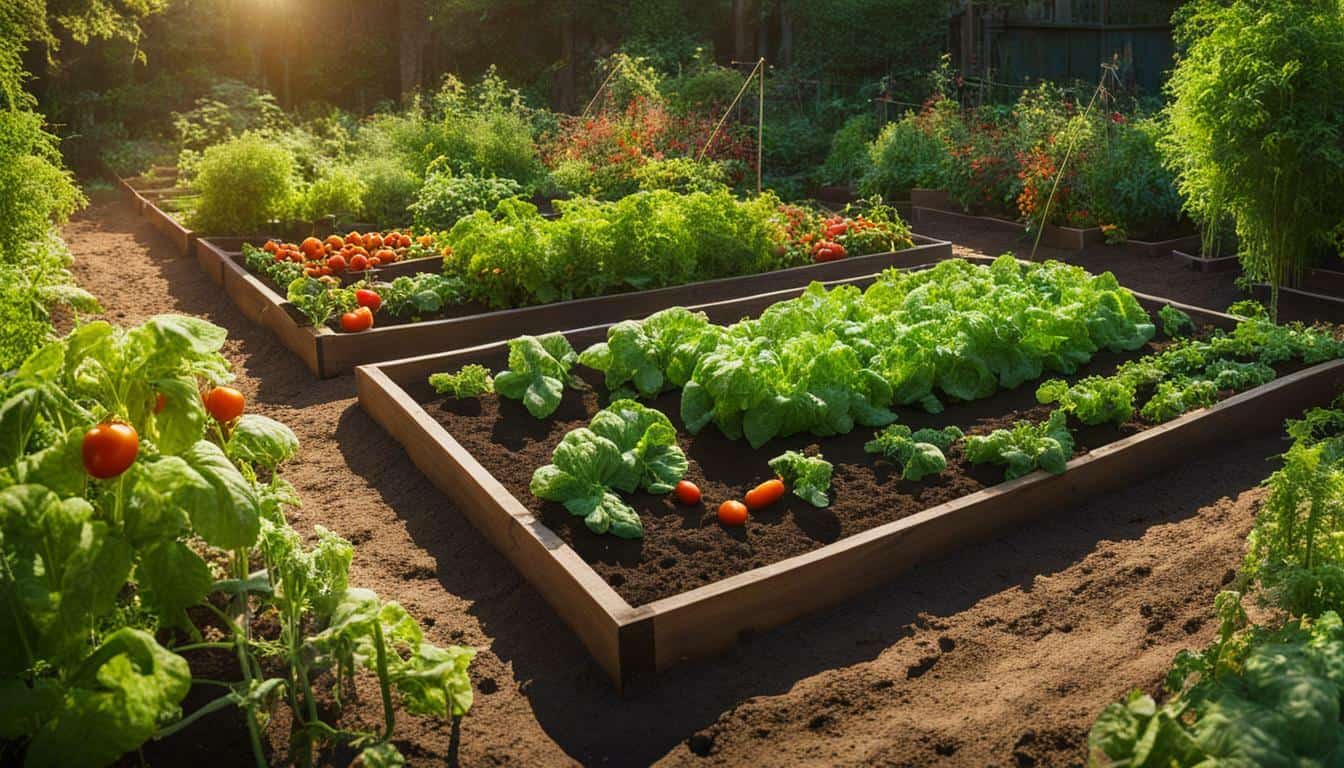



Leave a Reply